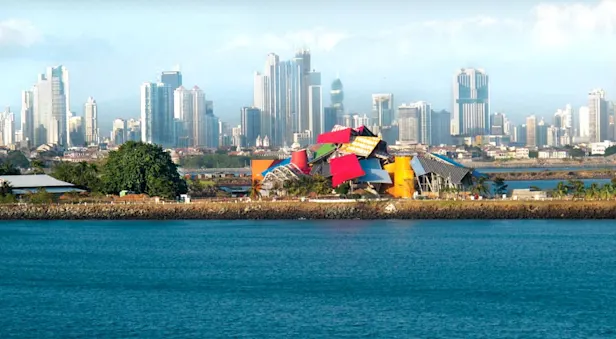Itinerary
Please Note:The itinerary below describes the Panama to Costa Rica voyage. From Costa Rica to Panama, the itinerary operates in reverse, with the same inclusions.
Our Panama and Costa Rica cruise begins in Panama City, the country's capital. From here, we drive across the Isthmus of Panama to Colon where we embark ship for the first section of our Panama Canal transit, anchoring in Gatun Lake for the night. In 1904, the United States began building a canal that would provide a shortcut link between the Atlantic and Pacific Oceans, making trade and travel both faster and safer. When it was completed in 1914, ships no longer needed to go all the way around the tip of South America; they could cut through the canal saving 8,000 miles and several months of transit time. Today, roughly 14,000 ships pass through the Panama Canal each year—and one of those transits will be ours.
This morning offers a choice of two activities. Take a boat ride to the mouth of the Chagres River and hike on Panama Rainforest Discovery Center trails, or board Zodiacs for an excursion into Barro Colorado Nature Monument in Gatun Lake. This large island encompasses nearly 14,000 acres of wild jungle terrain and is inaccessible to most travelers. By special arrangement, guides from the Smithsonian Tropical Research Institute accompany us through the dense tropical forest that so challenged the builders of the canal. We then re-board the ship to continue our transit through this engineering marvel that embodies both the history and future of global shipping. We'll see the gargantuan Panamax and Neopanamax vessels—the biggest ships on Earth—as well as all the landmarks: the Amador Causeway, Bridge of the Americas, and the Centennial Bridge that frames the Gaillard Cut, which we pass through to enter the Miraflores Locks. A daylight journey through the canal cannot be guaranteed, since cargo ships have priority over passenger ships, but the canal is dramatically lit at night.
Our ship is equipped with expedition landing craft and kayaks, enabling us to explore the sea and wild shores at eye level. Today, we utilize both to access a cluster of small islands in the Gulf of Panama for a delightful introduction to the region’s prolific and varied birdlife. Observe large numbers of roosting and nesting seabirds including brown pelicans, magnificent frigatebirds and whimsical blue-footed boobies of Galapagos Islands fame.
Coiba, established as a UNESCO World Heritage Site in 2005, is one of Panama’s most remote national parks. The collection of 200 islands comprises part of the Marine Life Corridor protected area created in 2016 by the presidents of three nations—Costa Rica, Ecuador and Colombia—to safeguard sea turtles, sharks and a host of other offshore species. Only the Great Barrier Reef and Galapagos National Park are larger marine sanctuaries. Because Isla Coiba, the main island in the group, was formerly a penal colony, public access to the area was very restricted, and most of the islands' natural resources have flourished untouched due to limited human contact.
We'll have options for easy hikes on a network of trails through the lush tropical forest that blankets Isla Coiba, as well as numerous water activities: go kayaking, paddleboarding, swimming or snorkeling among schools of colorful tropical fish. The ship's staff will assist both novice and experienced snorkelers alike. If you'd prefer to remain on the white sand beach, the ship's naturalist diver will take underwater footage, which is shared during our evening gathering in the lounge.
Today we make our first landfall in Costa Rica. At Casa Orquideas, a privately owned botanical garden accessible only by boat and special invitation, we'll see a profusion of orchids while looking for butterflies, tanagers, parrots and toucans. The beautifully landscaped garden also shows off hundreds of species of ornamental and edible tropical plants that have been collected and cared for since the garden's establishment in this remote area in the 1970s.
Later, we explore the forested bay of Golfo Dulce—"Sweet Gulf"—an ideal spot for kayaking, paddleboarding, Zodiac cruises and swimming. Golfo Dulce is one of Costa Rica's most scenic places, a site of serene natural beauty unmarred by any development, thanks to strong local efforts to promote conservation. Verdant rain forest, mangrove estuaries and golden beaches edge the shores of the large bay, which is home to dolphins and humpback whales. During our visit, we learn about plate tectonics under the gulf, the deep-seated forces responsible for Costa Rica's many volcanoes and geothermal hot springs.
We go ashore at Playa Blanca, a pristine sand and coral beach on the eastern shore of the Osa Peninsula. This promontory of land flanked by the Pacific Ocean on one side and Golfo Dulce on the other is one of Costa Rica's most remote destinations, a primitive paradise of primary rain forest, empty beaches and tiny settlements. Travel inland to meet some of the inspiring local residents who live in this far-flung corner of Costa Rica, sustaining a life on the land through cultivating cocoa, heart of palm and sugar cane—though their farms are small patches amid the dominant rain forest that blankets the peninsula in a thick green cloak. We'll share a meal with some local families during our visit, followed by time to hike in the mature rain forest or kayak in the peaceful waters of Golfo Dulce, the only tropical fjord on the continent.
Today we also visit the Latin American Sea Turtles (LAST) Association on the Osa Peninsula, where we assist researchers with data collection and hear presentations by the staff, including the head biologist who has dedicated her life to conserving these endangered reptiles. The center works primarily with the hawksbill turtle, which can weigh up to 200 pounds. As part of its work, the organization takes in injured animals, many having been entangled in fishing gear. They are nursed back to health and eventually returned to their native habitat in the Pacific Ocean. At the end of our visit, we are invited to participate in the release of rehabilitated turtles back into the sea—a poignant moment. In the evening, enjoy sunset drinks and a beach barbecue ashore.
We anchor off the Osa Peninsula today, with access to Corcovado National Park. This remote region on Costa Rica's southern Pacific coast lies off the standard tourist itinerary, and we'll savor an immersion in untouched tropical wilderness. National Geographic called Corcovado "the most biologically intense place on Earth," and we gain a sense of that after spending a full day exploring this coastal rain forest heavily populated with wildlife. We find all four of Costa Rica's monkey species here, five wild cat species, including Central America's largest jaguar population (all are very elusive, however, and rarely seen), two crocodile species, both two- and three-toed sloth, white-nosed coati, giant anteater and spectacular tropical birdlife, with the endangered scarlet macaw a special prize. Our exact landing spot for the day will depend on sea conditions. There will be opportunities to kayak through the transparent aqua water and/or trek through the rain forest in search of wildlife.
Our ship makes its way north to Puerto Caldera on Costa Rica's Pacific coast where we disembark this morning. A transfer is provide to the airport in San Jose for flights home, or on to other adventures.
Note: This itinerary should serve as a guideline only: actual stops are determined by weather, wildlife activity, and a host of other factors in order to provide the best possible experience. This flexibility is what makes traveling on our nimble expedition ships so much more rewarding than on a large vessel with a locked-in voyage plan.
Physical Rating: Easy to Moderate
Interested in extending your trip? Link it up with another adventure!

Panama City & San Lorenzo Extension
Witness history in the making at the recently expanded Panama Canal, see its works in detail, and capture close-up photos as enormous ships transit this engineering marvel.
































